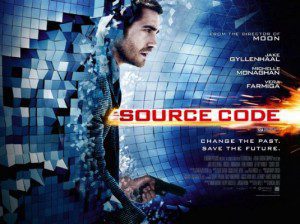 “Source Code” is a superior sci-fi action thriller, satisfying as entertainment while getting us to think about such small matters as what happens after death and whether the past can be changed. Captain Colter Stevens (Jake Gyllenhaal), a US Army helicopter pilot who has been flying missions in Afghanistan, wakes up in the body of an unknown man on board a Chicagoland commuter train. After the train blows up, he wakes up again in a bunker where a woman officer on a screen tells him he’s part of a secret government project tagged Source Code. His urgent mission is to identify the bomber on the train that just blew up. This is vital and time-sensitive because the bomber intends to explode a larger device in downtown Chicago that could kill millions.
“Source Code” is a superior sci-fi action thriller, satisfying as entertainment while getting us to think about such small matters as what happens after death and whether the past can be changed. Captain Colter Stevens (Jake Gyllenhaal), a US Army helicopter pilot who has been flying missions in Afghanistan, wakes up in the body of an unknown man on board a Chicagoland commuter train. After the train blows up, he wakes up again in a bunker where a woman officer on a screen tells him he’s part of a secret government project tagged Source Code. His urgent mission is to identify the bomber on the train that just blew up. This is vital and time-sensitive because the bomber intends to explode a larger device in downtown Chicago that could kill millions.
How can Colter help? By going back on board the train, inside the body in which he woke up before, and doing whatever is necessary to identify the bomber. He’ll go back as many times as necessary. Each time, he will have just eight minutes to do what he can. Since everyone except the bomber died in the blast on the commuter train, we come to realize that Colter is quantum-jumping into the body of a dead man, in his last eight minutes of life. We are given some scientific-sounding explanation of how this is possible along the lines that brainwaves have an 8-minute afterglow. Colter goes on jumping back into the body of the harmless history teacher on the train, gathering clues and developing a romantic interest, until he identifies the body and saves Chicago.
All of this is terrific fun, and the plot deepens. Spoiler alert: I have to reveal something of the film’s denouement to get to the best stuff. Colter’s assignment to play time detective by body-hopping is intriguing. But it seeds a larger question: if it’s possible to enter the past in this way, isn’t it also possible to change the past? The inventor of the Source Code project insists that past events cannot be changed. Colter decides to test this in a radical way. He succeeds brilliantly in his last eight-minute dash into a version of events in which he decides to stay. And shifts the world. He arrests the bomber and defuses the bomb on the train before it goes off, gets the girl, and stays in the borrowed body of the history teacher. Only one other person has any clue that the world is different. That’s how it is when we shift from one parallel universe to another. Most of us are completely unaware that before the shift, our world was other than it is now.
There’s a huge question left hanging. What happened to the soul of the history teacher whose body Colter now occupies? I won’t criticize a movie as good as this for not tackling all the big questions, but this is one that will stay with thoughtful viewers. Such questions, of course, can be explored through dreaming. I have no theology about these things, but it is my observation, as well as my personal experience, that active dreamers cease to have any doubts about the survival of consciousness after physical death, because they travel to afterlife locales and receive visitations from the dead. Similarly, active dreamers become aware of the reality of parallel universes and of the possibility of time travel or quantum jumping into the situation of people in other times, past or future or parallel.

